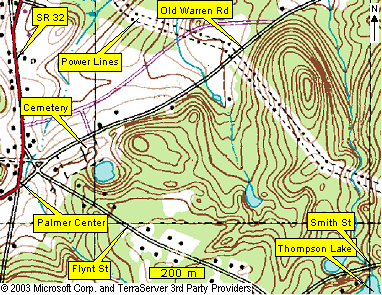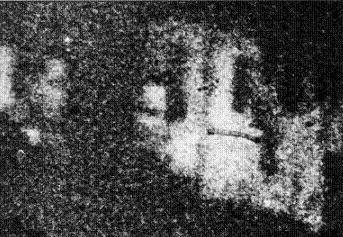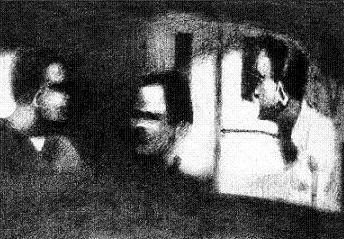
17 Feb 1967, about 9:45 PM, Palmer,
Massachusetts: Mrs. Stella V. Lansing, a housewife, part-time nurse, and mother
of five children, the oldest then in Vietnam, was parked with her car on Old
Warren Road, just off Route 32, in the double-row, high-voltage power-line area.
This was about a kilometer east of Palmer Center, away from street lights and
houses, alongside Burleigh park, and no more than a kilometer from her home at
Thompson Lake. Earlier this evening she had seen a yellow-orange globe of
light near the old cemetery and now hoped to see it again. She had been
puzzled frequently by strange lights in the Palmer area and this time brought a
borrowed movie camera. She was ready.
 |
Fig. 1. Sighting Area
|
Waiting patiently under a black,
starlit sky with the moon nearly half full, she saw three distinct globes of
yellow-to-reddish-orange light coming from the southeast, along the power line.
Except for an occasional cricket-like sound they were silent, as low as the
power line poles and no more than 20 m from them. Mrs. Lansing
recalls: "They generally glided, sometimes bouncing in a dipping manner, as
though riding the crest and ripples of a water wave." She started filming
the approaching objects and was amazed when they suddenly retreated: "They
bounced back like a rubber ball on a rubber string." She then realized
why, as a car came along, heading northeast toward West Warren. It stopped
and the driver got out, thinking Mrs. Lansing had car trouble.
The three globes were now hovering far back to the east, at about a 20-deg
elevation, one behind the treetops.
Mrs. Lansing recognized the young
lady, Ms. K., as an occasional visitor to Palmer and asked her to look at the
orange balls of light. Ms. K. was completely unfamiliar with the term
"UFO". In frustration, Lansing explained it to her, whereupon Ms. K.
became frightened and left. The strange objects now advanced as before,
gliding along the power lines.
Although no structural details were
apparent, Lansing felt someone must be guiding the globes. Concentrating
on one of them, she began waving "Hello". She did not forget to use the
movie camera and alternated between observing and filming throughout the entire
incident.
One of the objects, and then the
other two, became bluish-white and headed south-southeast, appearing to leave
the area. Lansing had photographed one of them at 16 frames per second
(fps) as it appeared to hover briefly about 20 m away from her. Now
she was about to leave and turned to film the moon, which was south.
Suddenly, from her left came a brilliant burst of white light, shooting up into
the air in a zigzag motion at a 45 deg angle, engulfed in swirls of white,
red, blue-to-bluish-green and yellow light. It had appeared to originate
from atop the knoll of a small hill, behind the second set of telephone poles in
the east-southeast, and was headed westward.
Lansing quickly proceeded to film
the object, first clicking the single-frame lever and then using 16 fps.
As she stopped to observe again, the object seemed to glide and suddenly changed
or extinguished all visible lighting, except for intermittent flashing of a
silvery-white, star-like light. This continued as the object moved lazily
but steadily along a westward heading, until it finally went out of range behind
trees and ground clutter.
Lansing had borrowed the camera from
her employer and this was her first experience with it. The Keystone
regular 8 mm "Capri" had a fixed lens, no telephoto, and did not have a
through-the-lens viewfinder. It was set at its largest opening of f/2.8
during the sighting and no filters were used. The Kodachrome II Daylight
spool was processed locally.
The resulting movie was first viewed
on an old projector, which unfortunately tended to burn the individual frames
when the stop-motion lever was held too long on "still". Lansing
evidently captured the zigzag motion by using the single-frame lever, but that's
all her photo shows -- a zigzag -- with no unambiguous structural detail.
The 16 fps sequence, about 4½ sec
long, has very low contrast, appearing as a yellow rectangle in the
upper-left-hand corner of the projected movie. In her studies of the film,
Lansing had switched to a battery-operated, hand-held viewer, to avoid burning
any more frames, and only moving, ghostlike images were apparent. Months
later, a modern projector was purchased. She recalls: "I had a shock of
disbelief as I was finally able to see four beings, two of which were turning
their heads and moving their lips as though conversing, and which then appeared
to be looking down at me."
Fig. 2 shows one frame
from this 4½ sec sequence. Fig. 3, sketched by artist Frederick E. Fahdt,
assists the reader in locating the three occupants in Fig. 2. The fourth
figure, not visible here, is standing to left in the movie scene. None appears to be the
grey alien type usually reported in close encounters nor, with dark hair, are
these the occasional blond "Nordic" types. Most striking is this veridical
human character of the images, even more evident from their animated movements
during projection. Who are these people? Could they be
archeologists
from Earth's distant future? With their casual and non-uniform garb, they
look more like university researchers than a military crew.
 |
 |
Fig. 2. Frame from 8mm movie; copyright
© 2008 by Stella V. Lansing
|
Fig. 3. Artist's clarification;
copyright © 2008 by Thomas M. Olsen
|
Lansing recalls: "I never saw them when filming...I can't tell you what...they came out of or what they were
in...They must have come from the soft, white object which seemed to go away to
the southeast -- the object that was hovering while I was filming, i.e., during
the sequence preceding the zigzag burst of light."
Four or five tiny orange lights are
visible above the window area during projection, regularly spaced on an arc of
larger radius. These suggest the window area on this UFO was below a
curved outer rim. Note the lateral compression of the standing figure on
the extreme right, like a Cinemascope® image viewed on a standard-definition,
4:3 television screen. This effect could be expected from the curvature of a thick,
cylindrical window.
A final, puzzling detail in the film
is a thin, vertical line, moving slowly but uniformly from left to right.
It crosses the field of view several times at regular intervals during the brief
16 fps sequence. It is a definite part of the image and cannot be validly
attributed to a scratch or artifact from processing or prior projection.
Lansing's movie was shown
informally at the end of the APRO 1971 "Eastern UFO Symposium", where one of the
featured speakers was psychiatrist / UFO researcher Berthold E. Schwarz, M.D.
He subsequently visited Mrs. Lansing twice in Palmer on five days of February
and April 1971, and studied her further at his New Jersey office during five
days of May 1971. These investigations were usually attended by members of her
family or close friends. Schwarz even enlisted the help of famed telepathist Joseph
Dunninger, as a positive check on her veracity. Schwarz's on-site field
trips to Palmer, numerous telephone calls and correspondence, interviews of her
associates, and his psychiatric evaluation and continuing interest in this case, are
documented for UFO researchers by seven articles in Flying Saucer Review
(see
Stewart's index). Dr. Schwarz's conclusions and comments in brief:
-
Stella Lansing told the truth as she saw it, and was quite modest about it: "These things happen and I don't know why"
-
Lansing had a history of paranormal experiences -- telepathic, precognitive, telekinetic, teleosomatic -- all within the range reported for psi-sensitive people
-
Subjects can be driven into psychosis by our failure to believe them; Lansing was affected by her strange experiences and required hospitalization. Schwarz clearly emphasizes that these experiences were cause, not result, of her psychosis, which subsequent treatment completely cured
-
Attempts to hypnotically regress Lansing were too traumatic and had to be abandoned
-
Lansing had taken many films and photographs of UFO-like and bizarre, non-UFO-like objects such as described by Ivan T. Sanderson
-
Careful, frame-by-frame analysis is necessary to see some of her photographed objects, which otherwise are overlooked
-
Facts of the case do not support a thoughtography (paranormal exposure) explanation: (1) Ted Serios claimed to produce single-exposures, while Lansing's 4½ sec sequence has many frames of complex movement, (2) Lansing and Schwarz simultaneously filmed anomalous objects on-site in Palmer with separate movie cameras and got consistent results
-
Question: how did Stella Lansing's psychopathology / psychophysiology make her a candidate for UFO interaction?
Sources: Personal communications
from Stella V. Lansing;
Flying Saucer Review
18, 1, pp 3-12, 19; 20, 5, pp 20-27
No comments:
Post a Comment